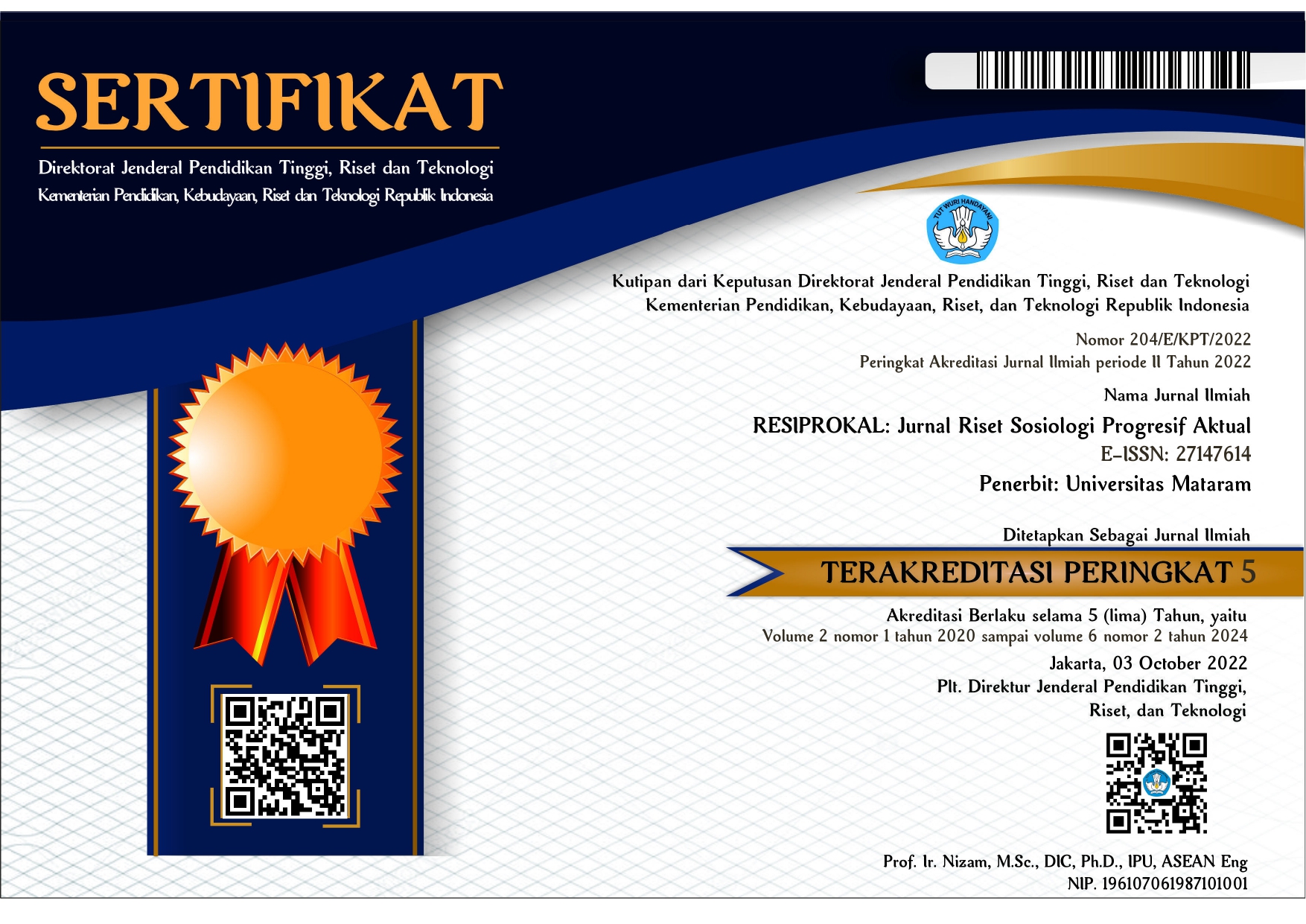Interaksi Sosial Termediasi Pembaca Alternative Universe (AU) “Slowmotion”
(Studi Netnografi dalam Kanal Close and Private Mediated Interaction Grup Telegram “Pasukan Bawah Tanah”)
DOI:
https://doi.org/10.29303/resiprokal.v6i1.466Keywords:
Telegram, Mediated Interaction, Alternative Universe, Netnography, Social InteractionAbstract
This article aims to explain the phenomenon of mediated social interaction of Alternative Universe (AU) story readers through Telegram social media which has characteristics as a close and private group, and to find out how AU readers form and maintain online social networks on Telegram. The method used in this research is a qualitative method using a netnography approach. In data collection techniques, researchers used observation, in-depth interviews, and documentation. To determine the informants in this study, researchers used purposive sampling technique, by determining in advance the criteria for informants to be studied. The data validity check technique in this research uses source triangulation technique. The results of this study show that even though they do not know each other personally, the AU story readers who are members of the “'Pasukan Bawah Tanah” Telegram group have intense mediated social interactions, by following every project made by the AU writer “Slowmotion” and establishing close friendships between members. In addition, the information distribution process carried out by AU readers who are members of the “'Pasukan Bawah Tanah” Telegram group is able to produce a number of joint content collaborations through the exchange of ideas between writers and group members. In these ways, the readers of the AU story “Slowmotion” and the members of the “Underground Troops” group can maintain the existence of themselves and their groups in the mediated social network through Telegram.
Downloads
References
Achsa, P. H. (2015). Representasi Diri dan Identitas Virtual Pelaku Roleplay dalam Dunia Maya (Permainan Peran Hallyu Star Idol K-Pop dengan Media Twitter). Paradigma: Jurnal Online Mahasiswa, 3(3): 1-12. https://ejournal.unesa.ac.id/index.php/paradigma/article/view/12966
Bramantio, R. D. (2017). Peran Jaringan Sosial dalam Distribusi Perdagangan Daging Sapi. (Studi Kasus pada Pedagang Sapi di Pasar Petarukan, Kabupaten Pemalang). Skripsi. Jurusan Sosiologi dan Antropologi, Universitas Negeri Semarang.
Damayanti, N. L., & Hidayat, M. A. (2019). Hiperreality of Social Media: A Phenomenology Study of Self Confession of Housewives of Facebook Users. The Journal of Society and Media, 3(2): 261-277. https://doi.org/10.26740/jsm.v3n2.p261-277
Eriyanto. (2021). Metode Netnografi: Pendekatan Kualitatif dalam Memahami Budaya Pengguna Media Sosial. Bandung: PT. Remaja Rosdakarya.
Fahana, J., Umar, R., & Ridho, F. (2017). Pemanfaatan Telegram sebagai Notifikasi Serangan untuk Keperluan Forensik Jaringan. Query: Jurnal Sistem Informasi, 1(2): 6-14. https://jurnal.uinsu.ac.id/index.php/query/article/view/1036
Hidayat, M. A. (2018). Homo Digitalis: Manusia dan Teknologi di Era Digital. Yogyakarta: Elmatera.
Hidayati, M., & Hidayat, M. A. (2021). Dramaturgi Identitas Perempuan Penggemar Karya Fiksi Homoseksual (Boys Love) di Indonesia. Jurnal Ilmiah Ilmu Sosial, 7(2): 159-169. https://doi.org/10.23887/jiis.v7i2.39338
Kusuma, A. D. (2019). Penggunaan Telegram Bot pada Telegram Messenger dengan Metode Webhooks untuk Sistem Peminjaman Insfrastruktur di UIN Maulana Malik Ibrahim Malang. Skripsi. Jurusan Teknik Informatika, Universitas Islam Negeri Maulana Malik Ibrahim Malang.
Kozinets, R. V. (2015). The International Encyclopedia of Digital Communication and Society. Canada: York University.
Lisanda, S., & Monang, S. (2023). Pemanfaatan Aplikasi Messaging Telegram @XKWAVERS Sebagai Media Komunikasi Fans K-Pop dalam Meningkatkan Value Diri dan Kesadaran Beragama. Jurnal Indonesia: Management Informatika dan Komunikasi, 4(3), 1105-1112. https://doi.org/10.35870/jimik.v4i3.339
Maulidya, M. N., & Hidayat, M. A. (2023). Studi Netnografi Deteritorialisasi Budaya Hallyu di Kalangan Penggemar Drama Korea. Jurnal Ilmiah Ilmu Sosial, 9(2): 146-159. https://doi.org/10.23887/jiis.v9i2.69289
Moleong, L. J. (2016). Metodologi Penelitian Kualitatf. Bandung: PT. Remaja Rosdakarya.
Nikmah, N. N. K., & Hidayat, M. A. (2024). Hiperrealitas Pembaca pada Utas Alternative Universe Boys Love Karakter Anime Chainsaw Man di X (Twitter). Journal of Urban Sociology, 7(1): 27-43. http://dx.doi.org/10.30742/jus.v1i1.3397
Rahman, F., Baidhowi, A., & Sembiring, R. A. (2018). Pola Jaringan Korupsi di Tingkat Pemerintah Desa (Studi Kasus Korupsi DD dan ADD Tahun 2014-2015 di Jawa Timur). Integritas: Jurnal Antikorupsi, 4(1): 29-56. https://doi.org/10.32697/integritas.v4i1.198
Sari, I. P., Andung, P. A., & Aslan, M. (2022). Perilaku Bermedia Sosial Mahasiswa Pengguna Telegram. Deliberatio: Jurnal Mahasiswa Komunikasi, 2(1), 99-110.
Syaharani, N., & Mahadian, A. B. (2017). Perilaku Menulis Fanfiction oleh Penggemar K-Pop di Wattpad. Jurnal Komunikasi Global, 6(2): 200-219. https://jurnal.usk.ac.id/JKG/article/view/9331
Vitri, N., Rondonuwu, S. A., & Waleleng, G. J. (2018). Peranan Media Sosial Instagram dalam Interaksi Sosial antar Mahasiswa Fakultas Ilmu Sosial dan Politik UNSRAT Manado. Acta Diurna Komunikasi, 7(4): 1-15. https://ejournal.unsrat.ac.id/v3/index.php/actadiurnakomunikasi/article/view/22022
Wellman, B. (2008). Physical Place and Cyberplace: The Rise of Personalized Networking. International Journal of Urban and Regional Research, 25(2): 227-252. https://doi.org/10.1111/1468-2427.00309
Wellman, B. (2012). Networked: The New Social Operating System. Cambridge: The MIT Press.
Wellman, B., & Berkowitz, S. D. (1988). Social Structures: A Network Approach. Cambridge: Cambridge University Press.
Zahra, S. N., & Yuliana, G. D. (2022). Hiperrealitas K-Popers terhadap Original Character Role Player (OCRP) Fanfiction di Twitter. Jurnal Publish, 1(2): 70-175. https://doi.org/10.35814/publish.v1i2.4218
Downloads
Published
How to Cite
Issue
Section
License
Copyright (c) 2024 Roesdiana Afrilia, Medhy Aginta Hidayat

This work is licensed under a Creative Commons Attribution-NonCommercial-ShareAlike 4.0 International License.







